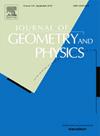CY/LG correspondence for Weil-Petersson metrics and tt⁎ structures
IF 1.2
3区 数学
Q1 MATHEMATICS
引用次数: 0
Abstract
The purpose of this paper is to establish the Calabi-Yau/Landau-Ginzburg (CY/LG) correspondence for the geometry structure, which is a generalized version of the variation of Hodge structures. To begin, consider a homogeneous polynomial of degree n. We can put a natural Hodge structure on the space of harmonic forms with respect to the twisted Laplacian (cf. §3.1). Additionally, there exists a natural Hodge structure on the cohomology of the Calabi-Yau hypersurface defined by f in the projective space . Naturally, one may question the relationship between these two Hodge structures and, more generally, the connection between the corresponding structures. As an application of our main result, we modify the real structure proposed by Cecotti on the Jacobi ring of f (cf. [8, (4.2)]). We show that this modified real structure not only aligns with pole-order filtration and Grothendieck residue pairing on the Jacobi ring of f, but it is also preserved by the residue map constructed by Griffiths-Carlson. Finally, it is crucial to emphasize that the CY/LG correspondence for the structures establishes the fundamental basis for studying the CY/LG correspondence for the genus one terms in the B-model.
Weil-Petersson度量和tt -结构的CY/LG对应关系
本文的目的是建立tt几何结构的Calabi-Yau/Landau-Ginzburg (CY/LG)对应关系,这是Hodge结构变异的广义版本。首先,考虑一个n次的齐次多项式f:Cn→C。我们可以在调和形式的空间上放置一个关于扭曲拉普拉斯Δf的自然Hodge结构(参见§3.1)。此外,在射影空间Pn−1中,由f定义的Calabi-Yau超曲面的上同调上存在一个自然的Hodge结构。自然,人们可能会质疑这两种Hodge结构之间的关系,更普遍地说,质疑相应的tt→结构之间的联系。作为我们主要结果的应用,我们修正了Cecotti在f的Jacobi环上提出的真实结构(参见[8,(4.2)])。我们证明了这种改进的实结构不仅符合f的Jacobi环上的极点过滤和Grothendieck残差配对,而且还被Griffiths-Carlson构造的残差映射所保留。最后,必须强调的是,tt结构的CY/LG对应关系为研究b -模型中一属项的CY/LG对应关系奠定了基础。
本文章由计算机程序翻译,如有差异,请以英文原文为准。
求助全文
约1分钟内获得全文
求助全文
来源期刊

Journal of Geometry and Physics
物理-物理:数学物理
CiteScore
2.90
自引率
6.70%
发文量
205
审稿时长
64 days
期刊介绍:
The Journal of Geometry and Physics is an International Journal in Mathematical Physics. The Journal stimulates the interaction between geometry and physics by publishing primary research, feature and review articles which are of common interest to practitioners in both fields.
The Journal of Geometry and Physics now also accepts Letters, allowing for rapid dissemination of outstanding results in the field of geometry and physics. Letters should not exceed a maximum of five printed journal pages (or contain a maximum of 5000 words) and should contain novel, cutting edge results that are of broad interest to the mathematical physics community. Only Letters which are expected to make a significant addition to the literature in the field will be considered.
The Journal covers the following areas of research:
Methods of:
• Algebraic and Differential Topology
• Algebraic Geometry
• Real and Complex Differential Geometry
• Riemannian Manifolds
• Symplectic Geometry
• Global Analysis, Analysis on Manifolds
• Geometric Theory of Differential Equations
• Geometric Control Theory
• Lie Groups and Lie Algebras
• Supermanifolds and Supergroups
• Discrete Geometry
• Spinors and Twistors
Applications to:
• Strings and Superstrings
• Noncommutative Topology and Geometry
• Quantum Groups
• Geometric Methods in Statistics and Probability
• Geometry Approaches to Thermodynamics
• Classical and Quantum Dynamical Systems
• Classical and Quantum Integrable Systems
• Classical and Quantum Mechanics
• Classical and Quantum Field Theory
• General Relativity
• Quantum Information
• Quantum Gravity
 求助内容:
求助内容: 应助结果提醒方式:
应助结果提醒方式:


